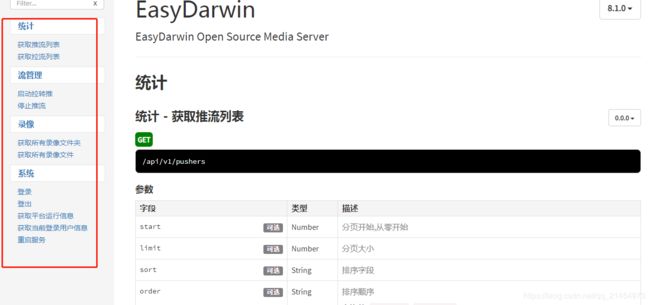利用流媒体将RSTP流转成WEB端可播放(使用EasyDarwin)
个人测试成功如下(Windows环境):
首先获取EasyDarwin:链接:https://pan.baidu.com/s/1HdZxwHrw3H8B6Ur4ctYOOQ 提取码:y18u
安装完成在计算机管理中可看到:
在安装目录中打开:
我的ini文件如下:
[http]
port=10000
default_username=admin
default_password=admin
[rtsp]
port=10554
; rtsp 超时时间,包括RTSP建立连接与数据收发。
timeout=28800
; 是否使能gop cache。如果使能,服务器会缓存最后一个I帧以及其后的非I帧,以提高播放速度。但是可能在高并发的情况下带来内存压力。
gop_cache_enable=1
; 是否使能向服务器推流或者从服务器播放时验证用户名密码. [注意] 因为服务器端并不保存明文密码,所以推送或者播放时,客户端应该输入密码的md5后的值。
; password should be the hex of md5(original password)
authorization_enable=0
; 是否使能推送的同事进行本地存储,使能后则可以进行录像查询与回放。
save_stream_to_local=1
;easydarwin使用ffmpeg工具来进行存储。这里表示ffmpeg的可执行程序的路径
ffmpeg_path=E:\tools\nginx\ffmpeg\bin\ffmpeg
;本地存储所将要保存的根目录。如果不存在,程序会尝试创建该目录。
m3u8_dir_path=F:\record
;切片文件时长。本地存储时,将以该时间段为标准来生成ts文件(该时间+一个I帧间隔),单位秒。
;如果需要直播,这个值设小点,但是这样会产生很多ts文件;如果不需要直播,只要存储的话,可设大些。
ts_duration_second=3
;key为拉流时的自定义路径,value为ffmpeg转码格式,比如可设置为-c:v copy -c:a copy,表示copy源格式;default表示使用ffmpeg内置的输出格式,会进行转码。
/stream_265=default这里要去下载个FFmpeg,并且配置成ffmpeg_path,下载链接:链接:https://pan.baidu.com/s/1btHQR4Ik3RKApjKPzvTUiw 提取码:2yl8 (直播需要)
本身的EasyDarwin有自己的接口文档:http://localhost:10000/apidoc/
所以可支持多语言,你只要发送HTTP请求即可。
这里先简单说下不用摄像头的rtsp的流:海康、大华、星邦网络摄像头的 RTSP协议 地址与格式
例如海康:rtsp://admin:[email protected]:554/H.264/ch1/main/av_stream
username: 用户名。例如admin。
password: 密码。例如worthsen123456。
ip: 为设备IP。例如 192.168.1.66。
port: 端口号默认为554,若为默认可不填写。
codec:有h264、MPEG-4、mpeg4这几种。
channel: 通道号,起始为1。例如通道1,则为ch1。
subtype: 码流类型,主码流为main,辅码流为sub。
我这边用的是JAVA,写的辅助工具类如下:
public class EasyDarwinUtils {
private static String serverAddress = localhost;//可自行修改
private static String serverPort = 10000;
private static String URL = serverAddress + ":" + serverPort;
private static final String PUSH = URL + "/api/v1/stream/start";
private static final String DELPUSH = URL + "/api/v1/stream/stop";
private static final String Find = URL + "/api/v1/pushers";
public static enum PassWAY {
TCP, UDP
}
public static enum FloatWay {
main, sub
}
public static final String stop(String id) {
String param = "id=" + id.replaceAll("\"", "");
try {
return sendGet(DELPUSH, param);
} catch (IOException e) {
// TODO Auto-generated catch block
e.printStackTrace();
}
return null;
}
public static final String rtspUrl(String name, String pwd, String ip, int port, String code, String channel, FloatWay f) {
if (StringUtils.isBlank(name) || StringUtils.isBlank(pwd) || StringUtils.isBlank(ip)) {
return null;
}
if (port == 0) {
port = 554;
}
if (StringUtils.isBlank(code)) {
code = "h264";
}
if (StringUtils.isBlank(channel)) {
code = "ch1";
}
return "rtsp://" + name + ":" + pwd + "@" + ip + ":" + port + "/" + code + "/" + channel + "/" + f
+ "/av_stream";
}
public static final String start(String rtspUrl, String cumtomPath) {
return start(rtspUrl, cumtomPath, PassWAY.TCP);
}
public static final String start(String rtspUrl, String cumtomPath, PassWAY way) {
String param = "url=" + rtspUrl + "&customPath=" + cumtomPath + "&transType=" + way;
try {
return sendGet(PUSH, param);
} catch (IOException e) {
// TODO Auto-generated catch block
e.printStackTrace();
}
return "Path";
}
public static final String find(String rtsp) {
String param = "q=" + rtsp;
try {
return sendGet(Find, param);
} catch (IOException e) {
// TODO Auto-generated catch block
e.printStackTrace();
}
return null;
}
private static String sendGet(String url, String param) throws UnsupportedEncodingException, IOException {
String result = "";
BufferedReader in = null;
HttpURLConnection conn = null;
String urlName = url + "?" + param;
System.out.println(urlName);
URL realUrl = new URL(urlName);
// 打开和URL之间的连接
conn = (HttpURLConnection) realUrl.openConnection();
// 设置通用的请求属性
conn.setRequestProperty("accept", "*/*");
conn.setRequestProperty("connection", "Keep-Alive");
conn.setRequestProperty("user-agent", "Mozilla/4.0 (compatible; MSIE 6.0; Windows NT 5.1; SV1)");
conn.setRequestProperty("Accept-Charset", "utf-8");
conn.setRequestProperty("Content-Type", "application/x-www-form-urlencoded;charset=" + "utf-8");
conn.setDoInput(true);
conn.setRequestMethod("GET");
// 建立实际的连接
conn.connect();
// 获取所有响应头字段
Map> map = conn.getHeaderFields();
// 遍历所有的响应头字段
// for (String key : map.keySet()) {
// System.out.println(key + "--->" + map.get(key));
// }
// 定义BufferedReader输入流来读取URL的响应
in = new BufferedReader(new InputStreamReader(conn.getInputStream(), "utf-8"));
String line;
while ((line = in.readLine()) != null) {
result += line;
}
return result;
}
} 测试:
public static void main(String[] args) {
System.out.println(start("rtsp://admin:[email protected]:554/h264/ch1/main/av_stream", "192.168.1.64/main"));
}控制台打印的是推流的ID :
看下有没有成功:
VLC播放rtsp流的方法百度一下,我这边用的是VLC player:
可以看到我们已经成功的拿到流了,不过web端怎么显示呢?
省略曲折的过程,先看我代码怎么拼接的:
ipcEquipment.setEasySubUrl(ServerURL + "/record/" + ipcEquipment.getIp()+"/sub"+"/"+today+"/out.m3u8");
ipcEquipment.setEasyUrl(ServerURL + "/record/" + ipcEquipment.getIp()+"/main"+"/"+today+"/out.m3u8");实际上是:"localhost:10000/record/" + cumtomPath +"/"+today+"/out.m3u8",
cumtomPath 是我们请求接口是带的参数,today的样式为YYYYMMDD(如今天20190401),然后利用video标签进行播放:
videojs支持hls直播实例
JS百度即可。
然后用谷歌浏览器运行:
各项时间差如图,如果嫌延迟时间太长(20s都忍受不了的),可以再调节ini文件中的ts_duration_second参数(调小)
总的来说到此应该结束了。
在此感谢EasyDarwin的开源者!
欢迎沟通交流,告辞!






